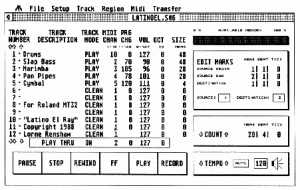Because they really can’t teach this stuff in school. Well maybe they try to at Berklee College of Music or some trade schools. But you’re not going to go there because you are wise (or cheap, or too young/old, etc). This can’t be contained in one article, as it’s way too broad a subject, but here’s a crash course:
First, you need a canvas to paint on. Get some DAW (Digital Audio Workstation) software. I won’t even bother going into the DAW war and just state I use Digital Performer 6 for a multitude of reasons that fit me (I’ve traveled a long road from Midisoft Studio 4 for Windows 3.0*). Others of note on my list are Logic and Pro Tools (Yes I use a Mac for music, stop whining). The Cakewalk stuff for PC is great too. It really doesn’t matter which one you choose, as long as it works for you (and it cost you more than 5$ from a shady shareware site).
Next, you need some paint to put on the canvas with; that is, instruments. You used to need a sampler and then instruments, but it seems that every instrument company has rolled their own software samplers. I still use NI Kontakt2 and MOTU Mach5 (because I still have some ancient and custom samples I like using). Anything from East-West and VSL is top notch. MOTU makes some other great stuff too (Ethno). Looking pricey? You can pick up Mach5 for around $200 nowadays which will include all your basic sounds and it includes a set of VSL instruments.
Now to put the pain, err paint on the canvas! Writing… you’re really on your own. I could give you all sorts of BS and Theory that was shoved down my throat in university, but it seriously just comes down to creativity and trial and error, and… I hate the word, but, ‘talent’**. Write a LOT! Write at least one hundred songs before you can really get a feel for what it is you are doing. The key to good music writing is to write a lot of bad music on purpose (and on accident). Don’t write for money or fame, just write to make interesting sounds. Experiment. You’ll know you are getting better when someone asks, ‘What is that weird crap coming out of your speakers?’ or alternatively someone asks, ‘What is that lovely music coming from your sound system?’
As far as Production tips (the frame for the canvas): save all your money and just use the plugins that came with your DAW software, they are surprisingly good. Then when you have enough dough, get some Waves plugins, at least the Renaissance set, they sound incredible and they are expensive for a reason. The rest…go to tweakheadz for all the technical stuff you need to know (and I don’t care to write). His articles are mostly well written and can emit a good laugh or two.
Hope that gets you started in some direction.

